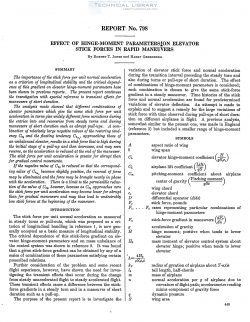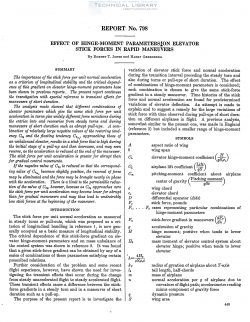naca-report-798

- Version
- 187 Downloads
- 692.09 KB File Size
- 1 File Count
- August 30, 2016 Create Date
- August 30, 2016 Last Updated
National Advisory Committee for Aeronautics, Report - Effect of Hinge Moment Parameters on Elevator Stick Forces in Rapid Maneuvers

The importance of the stick force per unit normal acceleration
as a criterion of longitudinal stability and the critical depend-
ence of this gradient on elevator hinge-moment parameters have
been shown in previous reports. . The present report continues
the investigation with special reference to transient ejects for
maneuvers of short duration.
The analysis made showed that diferent combinations of
elevator parameters which give the same stick force per unit
acceleration in turns give widely difi'erent force variations during
the entries into and recoveries from steady turns and during
maneuvers of short duration such as abrupt pull-ups.
bination of relatively large negative values of the restoring tend-
ency 0,, and the floating tendency Chat, approaching those of
an unbalanced elevator, results in a stick force that is high during
the initial stage of a pullaup and then decreases, and may even
reverse, as the acceleration is reduced at the end of the maneuver.
The stick force per unit acceleration is greater for abrupt than
for gradual control movements.
If the negative value of 01,, is reduced so that the correspond-
ing value of 03% becomes slightly positive, the reversal of force
may be eliminated and the force may be brought nearly in phase
with the acceleration. There is a limit to the permissible reduc-
tion of the value of 0”, however, because as 0,, approaches zero
the stick force per unit acceleration may become lower for abrupt
than for gradual maneuvers and may thus lead to undesirably
low stick forces at the beginning of the maneuver.
The stick force per unit normal acceleration as measured
in steady turns or pull-outs, which was proposed as a cri—
terion of longitudinal handling in reference 1, is now gen—
erally accepted as a basic measure of longitudinal stability.
The critical dependence of this sticklforce gradient on ele-
vator hinge-moment parameters and on mass unbalance of
the control system was shown in reference 2. It was found
that a given stick-force gradient can be obtained by any of a
series of combinations of these parameters satisfying certain
prescribed relations.
| File | Action |
|---|---|
| naca-report-798 Effect of Hinge Moment Parameters on Elevator Stick Forces in Rapid Maneuvers.pdf | Download |
Comment On This Post